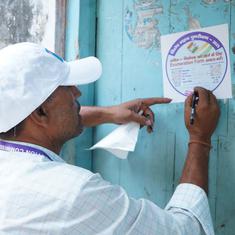Under the soft winter sun, Gurdeep Singh ran a handful of soil through his fingers, watching it crumble all too easily. The 65-year-old farmer from Balbehra village in Punjab’s Patiala district had seen the earth on his five-acre farm change over the decades – from fertile and self-sustaining to now being dependent on chemicals for survival.
“People talk about Punjab’s youth getting addicted to drugs, but no one mentions how our soil has become addicted to chemicals and fertilisers,” he said, looking out at the young wheat sprouting across his plot. Rising costs and declining yields, he explained, were symptoms of this deep-rooted crisis.
Once the poster child for the Green Revolution in the 1960s that resulted in an increased production of grains from 50 million tonnes to over 300 million tonnes in nearly five decades, Punjab faces a silent crisis – soil dependent on fertilisers, pests resistant to chemicals and declining crop yields despite rising input costs.
The problem is not unique to Punjab. Most Indian states face the same problem. This crisis signals a grim future for the country’s agriculture sector, threatening the sustainability of Indian agriculture and imperilling its access to safe and healthy food.
The final part of the three-part series on monoculture of water-intensive crops, and its impacts explores the ground realities of fertiliser use, the struggles of India’s farmers and considers the advice of experts for why reform is urgently needed.
Cropping diversity, fertiliser use
As monoculture dominates India’s farm sector, the overuse of fertilisers and pesticides has taken a toll on soil health, groundwater reserves and rural livelihoods.
Our analysis found direct links between monocropping and fertiliser use. Among the top 10 Indian states that consume the most fertiliser, six mainly cultivate just five crops on over 90% of the land.
Punjab ranks second in fertiliser consumption, while Haryana ranks fifth.
Ecological expert Soumik Banerjee explained this link. “Monoculture leads to increased fertiliser use because each crop type absorbs certain nutrients in large amounts,” he said. “When the same crop is grown season after season, those nutrients are rapidly exhausted, requiring artificial fertilisers to restore them.”
But when farmers plant diverse crops, the “different plants replenish and balance soil nutrients”, he added.
However, even with states that show greater crop diversity, a little over half of them use more fertiliser than the national average. This increased fertiliser usage is impacted by the cultivation of water-intensive crops despite crop diversity, which also require more fertilisers than crops that use less water.
States that cultivate a more diverse range of crops also tend to allocate a larger proportion of their agricultural land to water-intensive crops. In India, the top three states with the highest area under water-intensive crops are Tamil Nadu, Gujarat, and Maharashtra – all of which are known for their high crop diversity.
Among the crops grown in India, sugarcane consumes the most fertiliser, followed by potato, cotton, wheat and paddy, all of which are water-intensive crops.
Banerjee said that water-intensive crops use more fertilisers because they are often cultivated as monocrops. This depletes soil nutrients rapidly.
Even in states with diverse agriculture, large portions of farmland are dedicated to these crops. “This dominance leads to higher fertiliser use to replenish lost nutrients and sustain yields,” Banerjee explained.
Experts emphasise the need for systemic reforms to reduce the reliance on fertilisers and pesticides and to encourage crop diversification and including diverse crops like legumes, which are natural nitrogen fixers. The overuse of chemical fertilisers poses significant environmental challenges both in India and globally.
Studies have shown that only 46% of applied nitrogen fertilisers are absorbed by crops – the remainder is washed away into water bodies. This causes the growth of algae, which depletes oxygen levels and harms aquatic life.
Several studies indicate that nearly two-thirds of nitrogen and more than half of phosphorus applied as fertilisers become environmental pollutants.
The fertiliser-yield loop
Speaking with farmers in rural Punjab and Haryana, we found that they strongly believe fertilisers are essential to maintaining their yields and sustaining their incomes.
“Over the years, my use of fertilisers has risen dramatically, from six quintals to 20 quintals annually,” said Gurdeep Singh in Balbehra. “A lot has changed in the last two decades. Earlier, we didn’t rely on fertilisers and still cultivated successfully.”
But after the Green Revolution, he said, fertilisers became indispensable. “If we reduce the quantity, the yields drop significantly,” he said. “With groundwater levels depleting and soil quality worsening, we have no choice but to keep using these chemicals.”
This pattern has led to increased input costs, reduced yields and lower pest resistance.
Jarnail Singh, a 70-year-old farmer from the same village, said that fertiliser consumption has increased over the years on the three-acre farm on which he grows only paddy and wheat.
“Earlier, a 50 kg bag of urea or DAP [diammonium phosphate] was enough for one acre, but now, I need three 45 kg bags, each costing Rs 450, just for paddy,” he said.
He added that wheat cultivation is facing greater challenges with a proliferation of pests and weeds. “Earlier, one spray was sufficient,” he said. “But now, pests have become more resistant, making at least two sprays necessary.”
The rising need for weedicides and pesticides has added to farmers’ costs.
Losing soil and yield
Experts note that overusing fertilisers, pesticides and herbicides harms the microbial population in the soil. This disrupts the nutrient cycle and further diminishes soil fertility.
Ecology expert Banerjee explained that fertiliser raises the nitrate content in plants, making them more vulnerable to pest attacks. He noted that “nitrate is a very good food for insects”, which have simple digestive systems.
“Unlike complex molecules such as amino acids and proteins, which are harder to digest, pests prefer crops with excess nitrogen, especially those grown in monoculture,” he said.
Experts also emphasise that reducing fertiliser use can be effectively achieved through greater crop diversity. For instance, cultivating pulse crops can naturally fix around 60 kg of nitrogen in the soil, equivalent to the amount of nitrogen provided by three bags of urea.
Ramanjaneyulu GV, the executive director of the Centre for Sustainable Agriculture, an independent research organisation, explained how diversifying into different nonwater-intensive crops could help reduce this reliance. The government spends Rs 2,800 to subsidise each bag of urea – which works out to Rs 7,000 for three bags, he said.
That means that the country spends the same amount of money to import both urea and pulses.
“If pulse production is subsidised in states like Punjab and Haryana, it could address both issues – reducing the dependence on imports and fertiliser use,” he said.
In the 2025-’26 budget, Rs 1.7 lakh crore has been allocated towards fertiliser subsidies, along with GST exemptions to further lower costs.
However, experts say that while this subsidy-driven price benefits farmers in the short term, it leads to fertilisers being overused.
“Many farmers apply more than the required amount of fertiliser, believing it will enhance crop yields,” Ramanjaneyulu GV said. But this depletes soil health and increases the long-term dependency on chemical fertilisers, affecting agricultural sustainability.
However, farmers believe that if they are to increase their yields, it is essential for them to increase their use of fertilisers too.
“Yields have remained steady over the years, but only because fertiliser use has increased significantly,” asserted Daljeet Singh, a farmer from Shahpur village in Haryana. “If we were to reduce fertilisers or cultivate naturally, there’s a high risk that crops wouldn’t grow.”

But despite the increased use of fertilisers, states have reported lower yields. As per our data, nine out of 10 states cultivating less diverse crops have reported yields less than the national average.
States that cultivate less diverse crops have seen a 20% drop in yields in the last ten years. Haryana leads with a 88.95 % decline. In Punjab, the figure is 14.51%.
However, states with high crop diversity with relatively better soil health have shown a higher average annual yield than the national average. Over the last 10 years, Andhra Pradesh ranks second while Karnataka ranks eighth in terms of annual yields.
Ramanjaneyulu said that though farmers believe that fertilisers are becoming less effective, the real problem lies in declining soil productivity.
“The soil is losing its nutrients,” he said.
He highlighted the alarming rate of soil degradation. “Every year, 16 tonnes of topsoil are lost per hectare, and it takes nearly 200 years to regenerate,” he said. “In 10 years you will lose one inch of soil so you are losing fertile soil rapidly and this has reduced yields over the years.”
This is the last of a three-part series.
Reporting for this story was supported by the Environmental Data Journalism Academy – a programme of Internews’ Earth Journalism Network and Thibi.
Methodology : The author conducted data analysis and interviews to produce this report. The data sets used for the study were data on the area, production, and yield of various crops, state-wise for 2013-2023, soil health data available for 2023-24, and fertiliser and pesticide use data available from the fertiliser statistics 2021-22. The author analyzed the area under cultivation for each state and identified states with low crop diversity as the ones cultivating five of less than five crops in more than 75% of their total area under cultivation. These states were then analysed for their soil health, fertiliser use, pesticide use, yields, and area under cultivation for water-intensive crops.
The analysis can be found here.
To validate the data and corroborate the findings, the author traveled to villages in Punjab and Haryana to meet the farmers and understand their ideas of crop diversification and their challenges.
The author also interviewed experts with backgrounds in agriculture and soil health to get their insights into explaining the interlinkage between crop diversity, water-intensive crops, and soil health.










